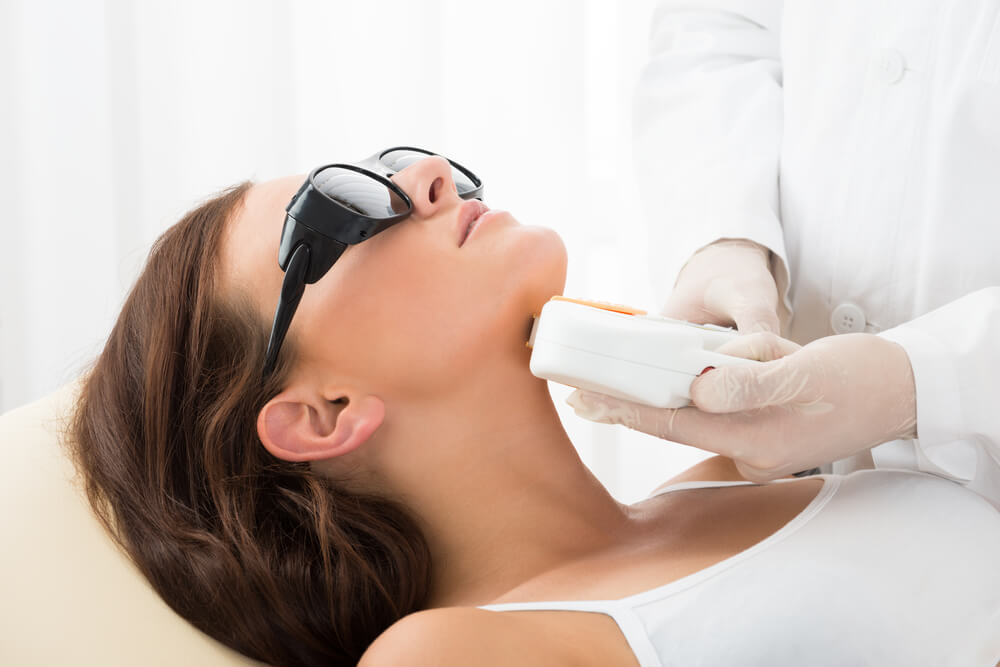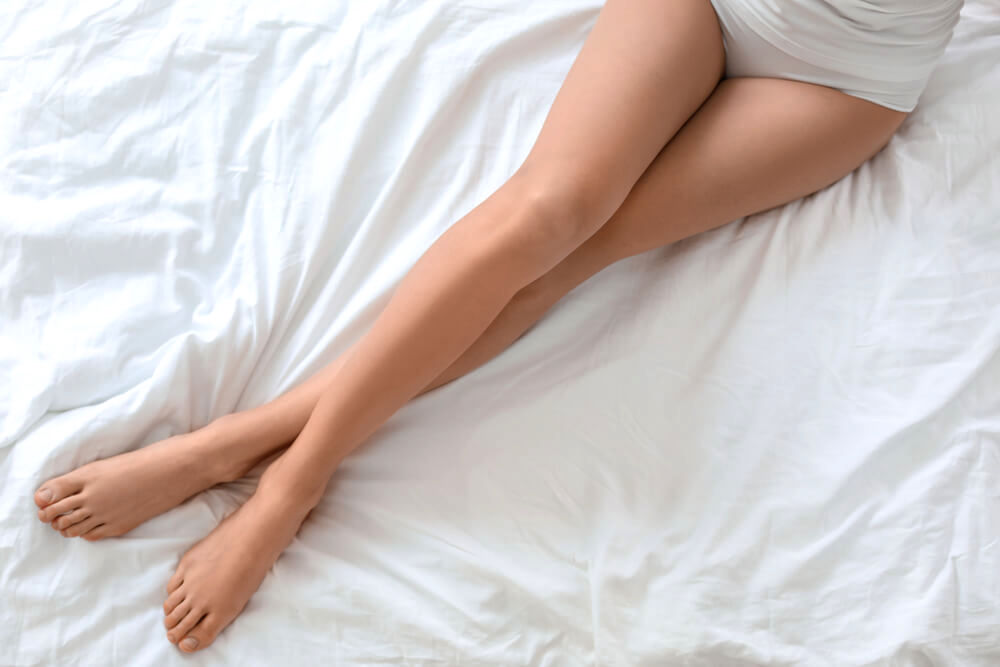I know the thought of getting rid of hair permanently sounds great. Sounds even better if you can do it in the comfort of your own bedroom. But if you’re considering at-home laser hair removal, I’m here to tell you why you shouldn’t.
Safety
You’re dealing with a powerful machine. No matter how cute and portable the design is, or regardless of the shades of pink and purple used, laser hair removal devices are not something to be taken lightly. Here’s a quick rundown of how they work:
The device emits a light, which the pigment in your hair (melanin) absorbs. When this happens, the light energy is converted to heat, breaking down hair follicles in the skin.
Sounds cool, I know. But imagine a situation where, instead of breaking down the melanin in the hair follicle, it breaks down the melanin in your skin?
If this should happen, it can lead to burns, scars and hyperpigmentation, especially if you decide to treat an area that’s not suitable for hair removal. For example, areas with hair that’s not ripe enough for treatment.
For those of you who don’t know what hyperpigmentation is, it’s a condition that occurs when your skin is exposed to inflammation, burns, or trauma. This then leads to the area of damage healing darker than your original skin tone. Those pesky dark spots after a nasty pimple are a prime example. You may also get hyperpigmentation from an increase in hormones, birth control pills or UV radiation.
That’s why it’s particularly important to make sure you know what exactly it is you’re doing when operating a laser hair removal device.
These sorts of risks are greatly reduced if you’re dealing with a qualified dermal or laser therapist. They’ll assess your skin type, and then tell you if your hair is suitable for laser hair removal. All of which is done in a clean, controlled, and professional environment. Sure you’ll spend more money, but it’ll ensure you’re not creating irreversible damage, or an even more expensive clinic visit to treat an unsightly scar.
The fact that the FDA doesn’t even regulate at-home laser hair removal devices immediately puts me off. And honestly, so should you.
Laser hair removal is a medical procedure, which requires training to be able to properly operate the device. My advice, if you don’t have a certificate in laser therapy, please do yourself a favor, and empty that Amazon cart right now.
Effectiveness
Sufficient and adequate heat is required to destroy a hair follicle. If not enough heat is applied to the treatment area, instead of getting rid of dark, thick hair permanently, you’re just left with fine, discolored hair.
This is a major problem because it makes it harder to treat such hairs down the line.
You should also consider the fact that each hair type and skin type will need a different kind of laser, which in turn requires its own amount of heat. Darker skin tones and lighter colored hair require specific and targeted heat energy to effectively destroy hair permanently. You must remember that laser hair removal isn’t a “one size fits all” procedure.
Every laser produces an output wavelength which is measured in nanometers (nm). These nanometers determine the penetration of energy which the device emits. This dictates the overall effectiveness of the laser for each patient’s skin and hair type. Even on your own body, you might notice some hairs grow thicker and darker than others. So why would you expect the same laser to treat such obviously different areas?
A device used at home won’t take this into account, which can definitely lead to, yup you guessed it, burns, scars and hyperpigmentation.
But clinics such as Introlift offer different wavelengths, such as Alex 755nm, 810nm, and YAG 1064nm, which cater to the unique needs of every patient. This ensures that you’re not left with skin resembling a cigarette burned lounge chair. Here’s a brief breakdown of how each wavelength works:
- Alex 755nm – This laser uses the alexandrite crystal as it’s laser source. The alexandrite laser produces a wavelength of light in the infrared spectrum (755nm). These types of lasers are red light lasers. They’re effective for dark hair patients with light colored skin. Patients with darker skin or tans should avoid this laser because it can damage melanin, leaving behind hypopigmentation (white patches of skin).
- Diode 810mm – What makes this laser special is its speed, which allows it to operate at 10 hertz per second. Faster laser, lesser treatment time. The laser is also able to treat darker skin and tanned patients. Making it a more versatile device that can used by a variety of people.
- YAG 1064nm – Another laser which is suitable for all skin types, these penetrate deeper into skin, which ensures a significant delay before hair begins to grow again in treatment areas. The downside is that this laser may be more painful than the other two mentioned above.
As you can see, there’s a lot to consider when you’re thinking of using a laser hair removal device. Skin type, hair color, and treatment area are all factors that must be put into consideration to ensure the success of the procedure. And no matter how well at-home devices are marketed, there just hasn’t been one that’s been created to account in such vast variations of customer use.
Coverage
Most people purchase an at-home laser hair removal device because they’re aiming to get rid of unwanted hair. Obviously, at first glance, it seems like a great option. Until you consider some of the areas where you have unwanted hair.
You may think your legs are probably easy enough to do, but what about your armpits, your backside, your neck?
At-home laser hair removal devices basically allow you to treat areas that are easily reachable by your hands, which is quite limited, unless you’re Mrs. Incredible of course.
Even areas that are easy to get to, may be too big for at-home laser devices to work effectively. By the time you finish treating two arms and a leg, the performance of the device might have been significantly reduced, leaving you with the appearance of some exotic hair condition. The upside of which is you’ll probably be featured in a page of the Guinness Book of World Records.
Getting an at-home laser hair removal device may seem like a more convenient option, but in the long run, you’ll not be happy with the results achieved. Unless you’re just looking to remove a couple of foot hairs or three.
Using a clinic assures that someone else, a COMPETENT someone else, is there to help you get rid of every single pesky hair on your sculpted booty cheek. This also reduces the risk of you cramping up and accidentally applying the laser to a very, very sensitive area. Yikes.
Device Calibration
Laser hair removal devices all go through a process of component degradation. These changes result in a reduction of energy. When this happens, the device can become unpredictable in its use, leading to a device that doesn’t work, or a device that leaves you with burns, scars, and hyperpigmentation (I know you’re probably tired of hearing that by now).
The devices need to be calibrated on a regular basis, which guarantees that they are delivering the right quantity of energy, ensuring their effective and efficient use. Most at-home laser hair removal devices don’t offer any form of calibration service, or even a warranty to protect against a device that has lost its power to work properly.
Not to mention that the steps of laser hair removal device calibration are very technical. You can’t just watch a YouTube video, cross your fingers, wrinkle your nose, and hope for the best.
If you don’t have a background in science, most especially in physics, you’ll probably be confused very fast. Which, come to think of it, even if you did have a degree in rocket science, you definitely wouldn’t be considering buying an at-home laser hair removal device.
Time
The most ironic part of using laser hair removal devices at home is that they take more time to achieve significant results than if you had visited a certified clinic.
Not only do you have to maneuver and twist your body like some sort of circus contortionist, but you’re also dealing with a device that is much less advanced than one you’d find in a clinic. What this equates to is a slower rate at which each laser is shot into hair follicles. This is an important consideration, because the slower the laser, the more time you must spend on any given area.
With modern laser removal devices, you’re able to cover large areas very quickly and efficiently. After just a few sessions, you’ll be significantly closer to having smooth, satiny skin. Most times a treatment can be performed during a lunch break. Some steps do need to be taken before you go in though, a few of which are listed below:
- Your area of treatment should be shaved at least 12 hours before your scheduled procedure.
- On the day of the laser hair removal procedure, you should wear loose fitting clothes, like sweats, or joggers.
- Alcohol and cigarettes are a big no-no the night prior to, and the day of the procedure.
- You should also avoid the use of skin care products, and ensure that the area is kept clean and dry before you go in for treatment.
- Lastly, don’t apply any self-tanners, or expose your skin to UV light (sunbeds or sunlight) for at least 8 weeks to the day of your laser hair removal procedure.
These steps may seem time-consuming, but I can guarantee you that they’re nothing compared to the time that you would spend trying to reverse skin damage. Sure, they could be done before an at-home laser hair removal treatment, but you wouldn’t get the necessary guidance needed from someone with experience. Remember, each skin type and hair type are different, so definitely the pre-care steps would be different too.
So, while you’re thinking you’re saving time and convenience, you’re not only doing the opposite, but also putting yourself at, sigh, the risk of burns, scars, and hyperpigmentation.
Aftercare
What happens after your laser hair removal procedure is just as important as what happens during. Skin needs to be properly cared for and monitored, so if any signs of irritation occur, then they can be treated immediately. Many of the people who buy at-home laser hair removal devices don’t have the appropriate knowledge needed to ensure skin is healthy after the procedure. The best bet is to visit a professional so you’ll be guided through the entire process.
The aftercare steps for laser hair removal are as follows:
- Apply an ice-pack on the area which was treated. This helps to diminish discomfort, pain and also reduces the possibility of any skin irritation.
- You should also apply aloe vera gel, or a non-steroid calming cream for at least three days after the treatment.
- Loose clothing should be avoided to prevent friction at the treatment area for at least 48 hours after the procedure.
- Make sure that the treatment area is kept clean and dry as well for 48 hours.
Skin that is not adequately treated can develop irritation, crusting, and, louder for the people at the back, burns, scars, and hyperpigmentation.
If you do use an at-home laser hair removal and unfortunately develop irritation, it’s advisable NOT to run and get the closest tube of over-the-counter (OTC) antibiotic. Using these can make the condition worse. What you should do is throw the device away and book a session with a dermatologist. Period.
I’m not trying to discredit people who sell and buy at-home laser hair removal devices, but I just want to make sure you know what you’re putting yourself at risk of. Your skin is an organ, and it shouldn’t be treated or handled in a way that can compromise its health. Lasers are not toys. Pretty packaging be damned. So, like I said earlier, empty that Amazon cart, and book a PROFESSIONAL laser hair removal treatment today.



